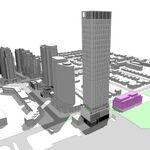Maybe you should realize that Amsterdam's contiguous urban area is like 15km across, maybe 25km if you use the most extreme measurement possible.
Toronto's continuous urban area is at least 30 km across no matter how you measure, and the only reason some measurements are only 30km is because of the lake. Most measurements are in the ballpark of 50km, and if you measure Burlington to Oshawa that's 100km.
30km from Amsterdam gets you to Utrecht. 50 gets you to Rotterdam. 100km gets you to Belgium. Or Germany. That's how terrible Toronto's car-centric sprawl is. Now, I wonder, where is Amsterdam's car-centric urban sprawl?
Distance to a highway is a silly question. The question more worth asking is, what proportion of OD pairs within a city have no reasonable alternative to driving? Or, what is the car mode share in the city? (hint: Amsterdam's is only 27% auto
https://en.wikipedia.org/wiki/Modal_share)
Amsterdam has good road infrastructure, good transit infrastructure, good cycling infrastructure, and good pedestrian infrastructure. Toronto has decent road infrastructure and terrible everything else.
The reason they can afford stuff and we can't is because as soon as you put cars on the pedestal and create massive swaths of car-centric urban sprawl, suddenly you need more roads, more services, more bus routes, more of everything per capita and per taxpayer, and suddenly you can no longer afford anything.




